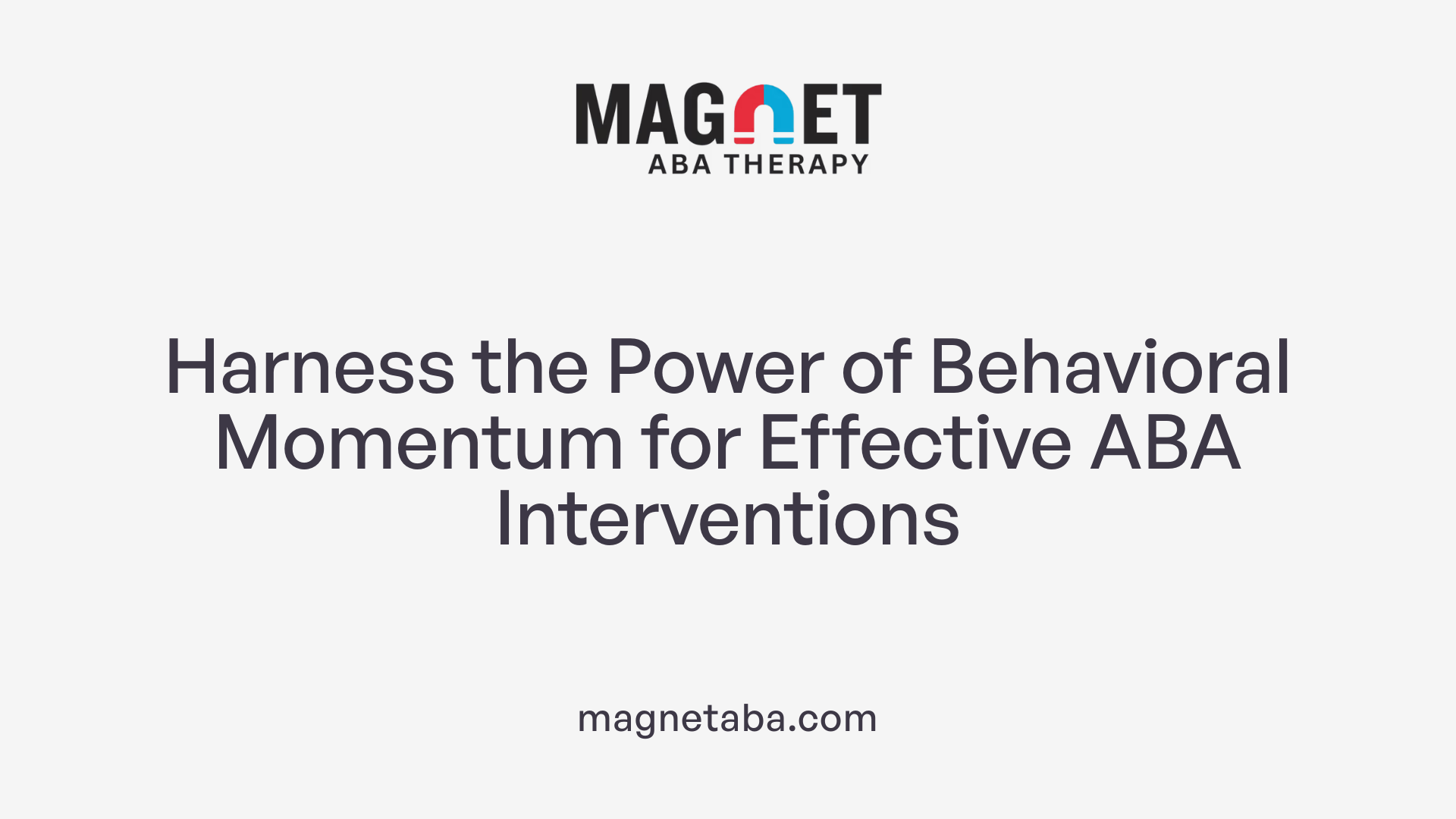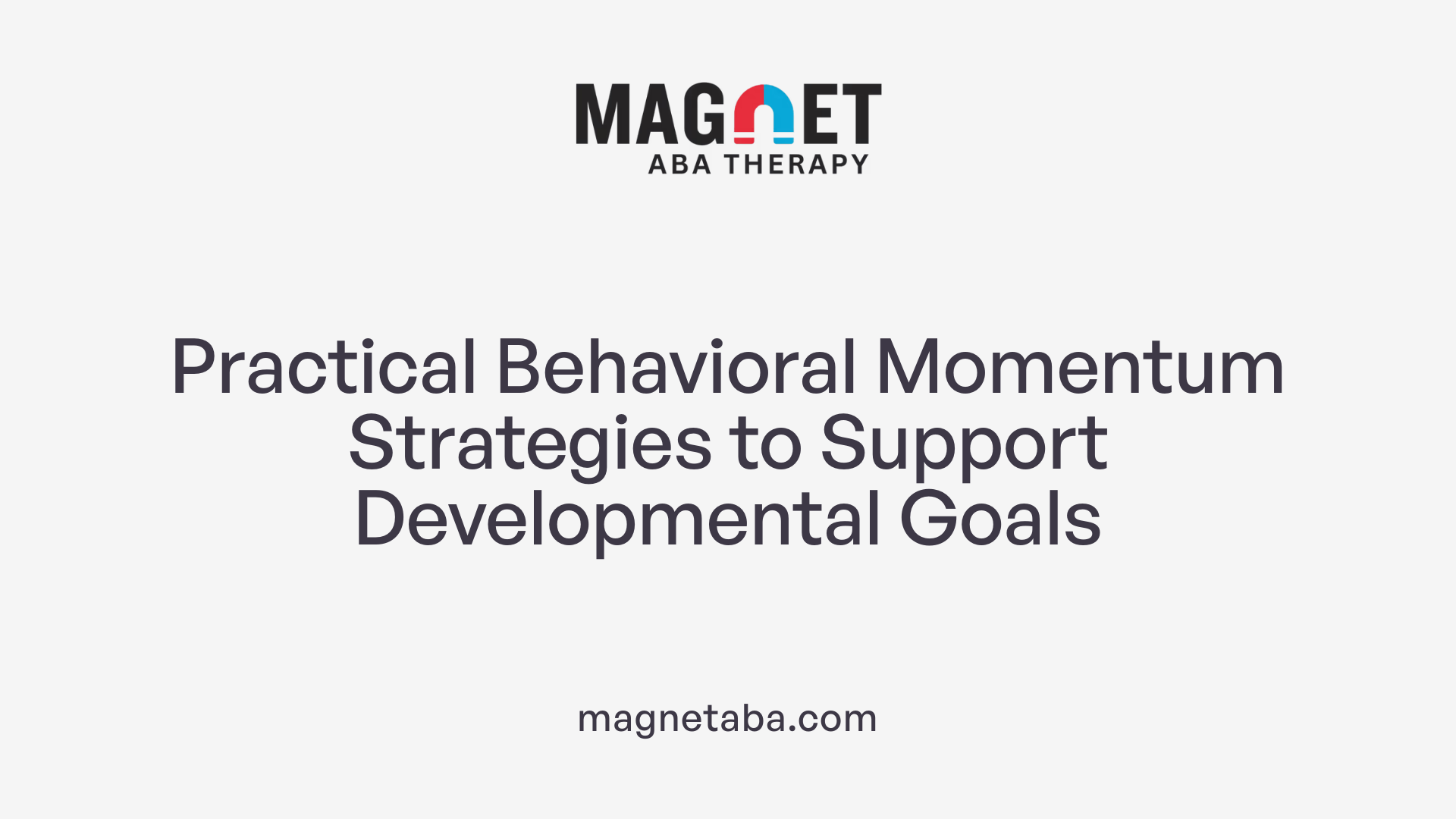Harnessing Psychological Principles to Improve Behavioral Outcomes
Behavioral momentum is a foundational concept in applied behavior analysis (ABA) that has gained prominence for its effectiveness in promoting lasting behavioral change, especially among individuals with autism and developmental disabilities. This article explores the core principles of behavioral momentum, its application within ABA, practical techniques for practitioners, and the scientific theories that underpin its success. By understanding these aspects, clinicians and caregivers can better leverage this strategy to foster resilience, compliance, and skill development.
Core Principles and Scientific Foundations of Behavioral Momentum in ABA

What are the core principles and definitions of behavior momentum in ABA?
Behavioral momentum in Applied Behavior Analysis (ABA) describes the tendency of behaviors to persist over time, especially in response to disruptions or changes in reinforcement conditions. The concept is rooted in the observation that behaviors reinforced frequently or with high response rates tend to continue even under challenging circumstances, such as during extinction or when faced with distracting stimuli. This persistence is similar to the physical concept of momentum, where an object with greater mass and velocity resists changes in motion.
A fundamental technique in ABA utilizing behavioral momentum involves the use of high-probability (high-p) request sequences. These consist of a series of easy, highly likely-to-be-completed tasks that are prompted and reinforced quickly and consistently. Successfully completing these tasks builds a momentum that increases the chances of compliance with subsequent, more difficult or less preferred tasks.
Research from sources like the Journal of Applied Behavior Analysis emphasizes that both the order of requests and reinforcement strategies are vital. Starting with well-mastered, reinforcing behaviors enhances motivation and engagement, ultimately leading to more effective acquisition of new skills. This approach reduces frustration and increases compliance, particularly beneficial for learners like children with autism spectrum disorder.
In essence, behavioral momentum in ABA reflects a strategic use of reinforcement history and task sequencing to foster behavioral persistence. It leverages the natural tendency of reinforced behaviors to resist reduction in response to changes, helping individuals to sustain positive behaviors and succeed in learning new skills.
How does the analogy with Newton’s laws of motion relate?
The analogy with Newton’s laws of motion supports the understanding of behavioral momentum by illustrating that behaviors with a strong reinforcement history behave similarly to objects with greater mass. Just as a heavier object resists acceleration, behaviors frequently reinforced resist disruption and are more likely to continue despite environmental changes.
This analogy highlights that behaviors with high response rates or reinforcement are more resistant to change because they possess greater 'mass' in a behavioral sense. Conversely, behaviors with low reinforcement history tend to be more easily disrupted and less likely to persist once the environmental conditions shift.
What is the role of reinforcement history?
Reinforcement history plays a crucial role in behavioral momentum. It refers to the cumulative past experiences where a behavior has been reinforced. Strong reinforcement history leads to increased response strength and resistance to change.
For example, if a child is consistently praised and rewarded for cleaning up toys, this behavior becomes more resistant to extinction or interference. When behavioral momentum is established through repeated reinforcement, the behavior is more likely to be maintained over time and across settings.
Can you explain the concept of resistance to change?
Resistance to change describes how behaviors, once reinforced, tend to continue despite attempts to modify or disrupt them. In ABA, this resistance is a function of reinforcement history and task sequencing. The higher the response rate and reinforcement in the past, the more resistant the behavior tends to be.
This concept is crucial for designing effective interventions. By emphasizing high-reinforcement and establishing behavioral momentum through rapid success and reinforcement, practitioners can increase the persistence of desirable behaviors. Over time, this resistance diminishes gradually, leading to sustainable behavior change.
Application of Behavioral Momentum in ABA Therapy and Treatment Strategies

How is behavior momentum applied within ABA therapy and treatment strategies?
In ABA therapy, the use of behavioral momentum starts with engaging individuals through high-probability (high-p) requests—these are simple, preferred, and easy behaviors that the person is highly likely to perform. This initial step involves presenting a series of three to five easy tasks rapidly, reinforcing each successful response immediately after it occurs. By doing so, the therapist builds a momentum of success, which fosters motivation and compliance.
Once this foundation is established, the therapist introduces a more challenging, low-probability (low-p) request. Because the individual has already experienced success and reinforcement, they are more inclined to comply with the harder task. This method effectively increases overall compliance, smoothens transitions between activities, and encourages perseverance with complex behaviors.
The scientific basis for this approach is rooted in the theory that behaviors reinforced consistently across time tend to persist even when conditions change. By starting with high-p behaviors, ABA practitioners use that reinforcement history to support less preferred behaviors. This technique is particularly beneficial for populations such as children with autism spectrum disorder (ASD), who often face difficulties with engagement, transition, or escaping tasks.
The result of applying behavioral momentum in therapy is an increase in response consistency and motivation. It builds a positive cycle of success, reducing frustration and error, ultimately enhancing learning and skill development.
Practical Techniques for Supporting Individuals with Developmental Disabilities

What are some practical techniques of behavioral momentum for supporting individuals with developmental disabilities?
Implementing behavioral momentum involves a series of strategic steps focused on building compliance and motivation in learners. One effective approach is to start with high-probability (high-p) requests—those that the individual is highly likely to respond to positively. These can include simple, fun tasks such as giving a high five, clapping, or saying 'hello'.
These easy requests are delivered rapidly in succession, with immediate reinforcement—like praise, tokens, or access to a preferred activity—after each successful response. This rapid, reinforced sequence creates a pattern of success, which increases the individual’s confidence and engagement.
Once a series of easy tasks has been accomplished and reinforced, the clinician or caregiver then gradually introduces a more difficult or less preferred task, called a low-probability (low-p) request. The key is to present the more challenging task immediately after the high-p tasks, minimizing the delay (within about 5 seconds) to capitalize on the momentum built.
This method reduces resistance and increases compliance because the individual’s motivation is bolstered by the success experienced earlier. Reinforcement continues consistently across all tasks, which helps maintain motivation and promote errorless learning.
Applying this technique across different environments and with various staff members fosters generalization, meaning the individual is more likely to respond positively in different settings. Over time, this strategy not only increases task completion but also reduces problem behaviors and makes transitions between activities smoother.
In summary, the practical application of behavioral momentum involves starting with easy, high-p requests, delivering rapid reinforcement, then quickly introducing more challenging tasks, all while maintaining consistency. This approach leverages the natural power of success and positive reinforcement to foster independent learning and reduce frustration.
Importance of Session Momentum in ABA

Why is session momentum important in ABA?
Session momentum plays a vital role in behavior analysis (ABA) by fostering a positive environment that encourages compliance and engagement. When therapists begin a session with easy, high-probability requests—behaviors the individual readily performs—they experience early success. This success boosts confidence and motivation, creating a momentum that makes it easier to introduce more challenging tasks.
The technique of using high-p requests before low-p behaviors is based on reinforcement principles, where repeated positive responses reinforce compliance. Delivering these requests rapidly and praising each response helps maintain the individual's focus and enthusiasm. Minimizing delays between responses and rewards further strengthens this momentum.
This strategy is especially useful during transitions, when regaining attention, or introducing new skills. By establishing a pattern of success early in the session, individuals are more likely to participate actively and complete difficult tasks without frustration. This consistent cycle of success not only makes sessions more efficient but also promotes generalization of skills across different settings.
Research from influential journals like the Journal of Applied Behavior Analysis highlights that behavioral momentum effectively increases task compliance and reduces problem behaviors over time. It supports long-term behavior change by reinforcing positive responses repeatedly, leading to more resilient and autonomous learners.
In summary, session momentum in ABA encourages ongoing compliance, enhances engagement, and helps build a foundation for acquiring and maintaining complex skills, ultimately contributing to meaningful, lasting behavioral improvements.
Behavioral Momentum versus High-P Approaches and Their Benefits

How does behavioral momentum compare to high-p (high-probability) approaches?
Behavioral momentum and high-p (high-probability) approaches share foundational principles in behavioral science, particularly the use of reinforcement to boost compliance and motivation. Behavioral momentum involves presenting individuals with a series of easy, high-probability tasks in rapid succession, creating a momentum that makes it more likely they will respond positively to more challenging or less preferred tasks afterward.
Similarly, high-p approaches focus on identifying tasks that the individual is likely to succeed at and delivering these in quick succession. The goal is to build confidence and compliance by reinforcing responses to easy requests, which then increases the likelihood of successful responses to more difficult demands.
Both strategies depend on the idea that success with simple, reinforcing tasks can carry over to more complex behaviors, reducing resistance and problem behaviors. The distinction lies in their emphasis: behavioral momentum centers on sustaining continuous easy tasks to maintain engagement, while high-p methods target establishing a pattern of success through reinforced, high-probability requests.
Research supports the effectiveness of both methods, especially when combined with positive reinforcement like praise, tokens, or tangible rewards. They are particularly useful in educational and clinical settings for promoting compliance, decreasing disruptive behaviors, and facilitating skill acquisition in children with autism spectrum disorder and other developmental challenges.
Promoting Response Persistence and Behavior Maintenance with Behavioral Momentum
How does behavioral momentum help build confidence and motivation?
Behavioral momentum works by starting with tasks that individuals find easy and are likely to perform successfully. Presenting 3-5 high-probability requests in rapid succession creates a pattern of success that boosts confidence. Each successful response is immediately reinforced through praise, tokens, or other rewards, which further motivates the individual to continue engaging.
This approach not only increases immediate compliance but also fosters a positive emotional state associated with task completion. As confidence grows, individuals are more willing to attempt and persist with more difficult or less preferred tasks, laying a foundation for sustained motivation.
In what ways does behavioral momentum support skill generalization across different settings?
One of the main advantages of behavioral momentum is its ability to facilitate the transfer of skills across various environments and caregivers. Because the strategy emphasizes reinforcing successful behaviors during structured sessions, skills learned through high-probability sequences are more likely to be reinforced and reproduced outside therapy or classroom settings.
By systematically building upon previously mastered behaviors and gradually introducing new challenges, behavioral momentum encourages consistency. This consistency helps individuals demonstrate their skills in different contexts, thereby promoting generalization and more robust learning.
How does behavioral momentum contribute to the long-term sustainability of behaviors?
Behavioral momentum supports long-term behavior change by establishing a pattern of success and positive reinforcement. As individuals repeatedly experience achievement and reinforcement, these behaviors become more resistant to disruption or extinction.
Research indicates that reinforcement history increases the persistence of behaviors, even when reinforcement is less frequent or when environmental distractions increase. Over time, behaviors initiated through behavioral momentum are more likely to be maintained because they are deeply embedded in a pattern of reinforced responses, leading to lasting change.
Can behavioral momentum help reduce problematic behaviors?
Yes, behavioral momentum can help reduce problematic behaviors by replacing them with more adaptive responses. When individuals are engaged in successive high-probability requests, their focus shifts away from undesirable behaviors.
This consistent engagement and reinforcement create a positive momentum that discourages frustration and avoidance. Additionally, the confidence gained from successful participation diminishes the need for escape or avoidance behaviors, leading to decreased problematic behaviors over time.
By reinforcing desirable behaviors and gradually increasing task difficulty, behavioral momentum fosters resilience and flexibility, reducing the likelihood of challenging behaviors in various situations.
| Aspect | Impact | Description |
|---|---|---|
| Confidence Building | High | Starting with easy tasks boosts self-efficacy |
| Skill Generalization | Strong | Skills transfer across settings and caregivers |
| Behavior Sustainability | Long-term | Reinforcement history promotes persistence |
| Behavioral Reduction | Effective | Decreases challenging behaviors through engagement |
This comprehensive approach makes behavioral momentum a valuable technique in applied behavior analysis, particularly for children with autism and other developmental disabilities. When effectively implemented, it enhances learning, promotes independence, and supports lasting positive behavioral change.
Response Persistence in ABA and the Influence of Behavioral Momentum
What is response persistence in ABA, and how does behavioral momentum influence it?
Response persistence in Applied Behavior Analysis (ABA) refers to the tendency of a behavior to continue occurring over time or across different settings, even when the original conditions that reinforced it are no longer present or have changed unfavorably. This persistence is especially important when trying to establish long-lasting, adaptive behaviors in individuals, such as children with autism.
Behavioral momentum theory (BMT) offers a scientific explanation for why certain behaviors persist longer than others. It draws an analogy to Newton’s laws of motion, where a moving object’s resistance to change is influenced by its momentum. In the context of behavior, this "momentum" reflects the behavior’s resistance to disruption.
BMT suggests that behaviors reinforced with high rates or potent reinforcement histories develop greater "behavioral mass." This increased mass makes these behaviors more resistant to disruptive influences, such as extinction or competing behaviors.
Imagine a behavior with a strong reinforcement history—such as receiving praise or rewards regularly. This behavior's high response rate and reinforcement strength contribute to a larger behavioral mass, making it more likely to persist even when conditions become less favorable.
The influence of behavioral momentum becomes evident in the presence of disruptors like distractions or satiation. While these disruptors tend to reduce the response velocity or frequency of a behavior, those with higher behavioral mass tend to resist these effects and continue occurring.
Several factors affect how persistent a behavior may be, including reinforcement history, baseline reinforcement rates, and the duration of treatment. For example, a behavior reinforced consistently over time is more resistant to change than a newly reinforced behavior.
Understanding these principles helps practitioners design interventions that foster durable behavior change. By increasing the reinforcement strength and maintaining high-probability requests, therapists can build behavioral momentum, leading to more resilient and enduring responses—ultimately promoting better learning outcomes and reducing the likelihood of problem behaviors returning.
Concluding Insights on Behavioral Momentum in ABA
Understanding behavioral momentum enhances the effectiveness of ABA interventions by leveraging the psychological principles of reinforcement, response resistance, and motivation. Practitioners can strategically use high-p request sequences and reinforcement to build momentum that fosters response persistence, reduces problem behaviors, and supports long-term skill development. The scientific foundations from theories like BMT provide a robust framework to predict and optimize behavior change strategies. Ultimately, integrating behavioral momentum into treatment protocols advances the goal of promoting resilient, autonomous, and engaged learners.
References
- Behavior Momentum - Nebraska Autism Spectrum Disorders Network
- B.22 Behavioral Momentum - AllDayABA
- What Is Behavioral Momentum in ABA Therapy?
- Behavioral Momentum - Golden Care Therapy
- BEHAVIORAL MOMENTUM THEORY: EQUATIONS AND ...
- Expert Columns: Behavioral Momentum - May Institute
- Identifying ways behavioral momentum can be used to understand ...












